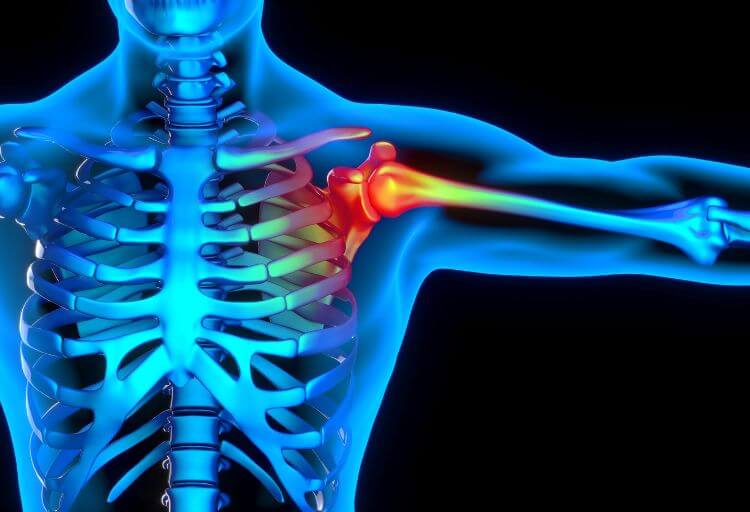Causes of shoulder joint pain
Injury to the acromioclavicular joint (AC joint injury)

Injury to the acromioclavicular joint occurs as a result of a collision with another player, e.g., in ice hockey, or a fall on the acromion.
The acromion may become pressure-sensitive, causing pain from pushing movements.
The diagnosis can be confirmed by X-ray, in chronic cases the degeneration of the clavicle head is common.
Therapy depends on the extent of the injury, with surgical treatment required in severe cases, and shoulder girdle strengthening and complex physiotherapy in milder cases.
Other causes of shoulder joint pain
- Sternoclavicular joint injury
- Injury to the joint at the junction of the clavicle and sternum is caused by trauma, the most common being an anterior dislocation of the joint. It can be caused by a strong blow to the shoulder from the side. It can be diagnosed safely with CT or MRI.
- Frozen shoulder develops gradually, accompanied by increasing pain in the shoulder joint. At the end of the process, the shoulder becomes almost immobile. It is caused by inflammation of the capsule of the shoulder joint, which often develops alongside arthritis. It is treated with steroid injections and complex physiotherapy, but immobilization of the joint does not help.
- Pressure from surrounding tissues on the nerves running around the shoulder joint and exiting the cervical spine often causes pain. In such cases, degeneration of the cervical spine is common, and symptoms often include numbness and aching pain in the upper limb.
Book an appointment for a consultation
Fractures of the elements of the shoulder joint
Fractures can require surgical or conservative therapy depending on the type of injury. After surgery, a complex physiotherapy and rehabilitation program is required in order to restore shoulder function and load bearing capacity. Failure to do so is almost certain to lead to reinjury and long-term deterioration of shoulder function.
Fractures are associated with significant loss of shoulder function and are accompanied by significant pain. X-rays are taken to diagnose fractures, but MRI scans are a significant aid in the diagnosis of collateral injuries and soft tissue injuries.
Prevention of shoulder joint injuries

The most effective way to prevent injury is a complex assessment of the shoulder girdle and spine, measuring muscle balance and range of motion with the help of appropriate equipment and a physiotherapist, and based on the results, creating a personalized complex exercise routine. (TSO Medical, Spinal Mouse, Physiotherapist Musculoskeletal Status, Sports Medicine Consultation)
The following link contains a general exercise routine compiled by the FIFA medical team to help you avoid injuries:

